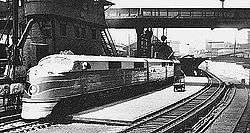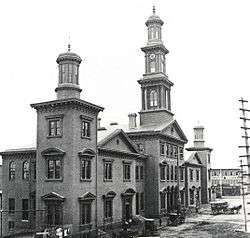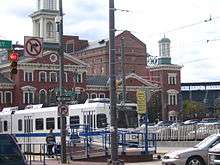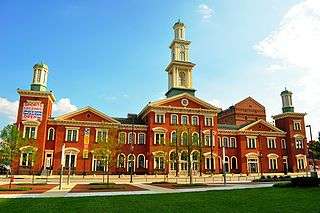Camden Station
| MARC, Baltimore Light Rail | |||||||||||||||||||||||||||||||||||||||||||||||||||||||
 MARC combination baggage/passenger coach parked on a stub track east of the B&O Warehouse | |||||||||||||||||||||||||||||||||||||||||||||||||||||||
| Location |
301 West Camden Street Baltimore, Maryland | ||||||||||||||||||||||||||||||||||||||||||||||||||||||
| Coordinates | 39°17′00″N 76°37′10″W / 39.28346°N 76.619554°WCoordinates: 39°17′00″N 76°37′10″W / 39.28346°N 76.619554°W | ||||||||||||||||||||||||||||||||||||||||||||||||||||||
| Owned by | CSX Transportation | ||||||||||||||||||||||||||||||||||||||||||||||||||||||
| Line(s) |
Commuter Rail:
| ||||||||||||||||||||||||||||||||||||||||||||||||||||||
| Platforms | 3 island platforms | ||||||||||||||||||||||||||||||||||||||||||||||||||||||
| Tracks | 6 (3 Light Rail, 3 MARC) | ||||||||||||||||||||||||||||||||||||||||||||||||||||||
| Connections |
| ||||||||||||||||||||||||||||||||||||||||||||||||||||||
| Construction | |||||||||||||||||||||||||||||||||||||||||||||||||||||||
| Parking | Yes | ||||||||||||||||||||||||||||||||||||||||||||||||||||||
| Bicycle facilities | Yes | ||||||||||||||||||||||||||||||||||||||||||||||||||||||
| Disabled access | Yes | ||||||||||||||||||||||||||||||||||||||||||||||||||||||
| History | |||||||||||||||||||||||||||||||||||||||||||||||||||||||
| Opened | 1867 | ||||||||||||||||||||||||||||||||||||||||||||||||||||||
| Traffic | |||||||||||||||||||||||||||||||||||||||||||||||||||||||
| Passengers (2013) | 399 (MARC daily average) | ||||||||||||||||||||||||||||||||||||||||||||||||||||||
| Services | |||||||||||||||||||||||||||||||||||||||||||||||||||||||
| |||||||||||||||||||||||||||||||||||||||||||||||||||||||
Camden Station, now also referred to as Camden Yards, is a train station at the intersection of Howard and Camden Streets in Baltimore, Maryland, served by MARC commuter rail service and local Light Rail trains. It is adjacent to Oriole Park at Camden Yards. Camden Station was originally built in 1856 by the Baltimore and Ohio Railroad as its main passenger terminal in Baltimore and is one of the longest continuously-operated terminals in the United States.[1]
History
Development
In 1852, the Board of Directors of the Baltimore and Ohio Railroad (B&O) approved the purchase of five blocks of land fronting on Camden Street at a cost of $600,000 for the construction of a new passenger and freight station to serve the city of Baltimore from a larger, more centrally-located site than the B&O's 1830s–1850s depot, Mount Clare Station.[2] Architectural renderings for Camden Station were submitted by the firm of Niernsee and Neilson in 1855. Construction began in phases in 1856 under the supervision of Baltimore architect Joseph F. Kemp, who also partly designed the final version, a three-story brick structure with three towers in the Italianate architectural style.[2][3] The center section was substantially completed by 1857; thereafter, the station was used by the B&O's passenger trains until the 1980s, one of the longest continuously operated railroad terminals in the U.S.[1] Construction was completed in 1867 with the addition of two wings and the towers following the end of the Civil War.[4] The station's center tower was originally 185 feet (56 m) high.[5]
Civil War years

In February, 1861, Abraham Lincoln travelled through Camden Station in February 1861, on his way to Washington, D.C. to be inaugurated as President of the United States.[6] News of the Battle of Fort Sumter, beginning the Civil War, first reached Baltimore on April 12, 1861, at the B&O's Camden Station telegraph office.[5] The following week, Union troops of the 6th Massachusetts Regiment travelling south on the B&O barricaded themselves at Camden Station when they were attacked by Confederate sympathizers in the Baltimore riot of 1861.[5] During the four-year conflict, the B&O's line between Baltimore and Washington, D.C. was the sole rail link between the Federal capitol and the North, resulting in a vital role for Camden Station as B&O's Baltimore terminal.[7] Trainloads of wounded soldiers and Confederate POWs came through the station following the Battle of Antietam, 75 miles (121 km) west of Baltimore on September 17, 1862.[6] President Lincoln changed trains at Camden Station on November 18, 1863 en route to Gettysburg, Pennsylvania to deliver the Gettysburg Address.[6] Lincoln also used Camden Station on April 18, 1864 when he made an overnight visit to Baltimore for a speaking engagement. A year later, at 10 a.m. on April 21, 1865, the assassinated president's nine-car funeral train arrived at Camden Station, the first stop on its slow journey from Washington to Springfield, Illinois, via the B&O and the Northern Central Railway's Baltimore-Harrisburg, Pennsylvania, line.[8]
In July 1877, the station was the site of riots and clashes between the Maryland National Guard and strikers during the Baltimore railroad strike, which occurred as part of the Great Railroad Strike of the same year. Some in the crowd attempted to set fire to the station, and nearby buildings associated with the Baltimore & Ohio Railroad, but were largely unsuccessful.[9]
Beginning in 1897, Camden Station also had lower level platforms for B&O's New York–Washington passenger trains, which used the Howard Street tunnel to reach Mount Royal Station. The first mainline electrification of a steam railroad in the U.S. occurred at Camden Station on June 27, 1895, when an electric locomotive pulled a Royal Blue train through the Howard Street tunnel.[10][11]
20th century

In 1912, the B&O remodeled the central waiting room, enlarging it and adding oak panelling with marble wainscoting for the Democratic National Convention, held in Baltimore that year.[12] The Annapolis & Baltimore Short Line Railroad also used Camden Station for its trains to Annapolis, Maryland, beginning in 1887. Except for an interval between 1921–1935, when the successor Washington, Baltimore and Annapolis Electric Railway (WB&A) used a separate station at Howard and Lombard Streets, frequent electric interurban trains to Maryland's capitol served Camden station until February 5, 1950, when WB&A successor Baltimore and Annapolis Railroad replaced rail passenger service with buses.[13] The first streamlined, non-articulated diesel locomotive in the U.S., EMC EA-EB #51, began using Camden Station's lower level platforms in 1937, pulling the B&O's famed Royal Blue. In addition to its New York–Washington service and frequent commuter trains to Washington, the B&O also operated extensive long-distance service at Camden Station to such cities as Chicago, Detroit, Cleveland, and St. Louis.[7] The Capitol Limited, Shenandoah, and Washington–Chicago Express to Chicago and the National Limited, Diplomat, and Metropolitan Special to St. Louis were among the many trains arriving and departing daily from the station during the first half of the 20th century. When the modern-era Major League Baseball Baltimore Orioles began playing in Baltimore, they arrived at Camden by B&O train from Detroit for their inaugural home opening game of the 1954 season.[14]
Declining rail passenger traffic in the 1950s–1960s led to substantial reductions in passenger train arrivals and departures at the venerable station. On April 26, 1958, the B&O discontinued all passenger service to Phildadelphia and New York, and Camden Station's lower level platforms were used thereafter only for a few trains serving Mount Royal Station. When Mount Royal closed in 1961, the lower level platforms were removed. Today, the lower level tracks and the Howard Street tunnel continue to be extensively used by freight trains of B&O's successor CSX Transportation, as part of its mainline system.[4] The inception of Amtrak on May 1, 1971, marked the demise of all B&O long-haul passenger service.[7] Thereafter, only B&O's local commuter trains, mostly Budd Rail Diesel Cars, continued to use Camden Station. Baltimore Sun commentator Jacques Kelly described Camden Station in its twilight years of B&O operation in the 1980s as, "Spotlessly maintained, it radiated the goodwill and a non-arrogant style typical of B&O employees ... its golden oak benches and large overhead lamps were maintained in the same pristine condition as when they welcomed delegates to the 1912 Democratic Presidential Convention."[14]
- MARC and Light Rail operations at Camden Station
 EMD GP40WH-2 #52 at Camden Station, July 2, 2004
EMD GP40WH-2 #52 at Camden Station, July 2, 2004 Light Rail train in front of the original Camden Station
Light Rail train in front of the original Camden Station
(background): B&O Warehouse and Oriole Park at Camden Yards
Current operations
The rail station is now served by both the Baltimore Light Rail and MARC's Camden Line commuter rail to Washington, D.C.. Baltimore Light Rail provides southbound direct service to BWI Airport and Glen Burnie, and northbound to Mount Royal, Lutherville-Timonium, and Hunt Valley. The MTA's Light Rail began service around the time that Oriole Park at Camden Yards opened. Its schedules refer to the stop as "Camden Yards": its name derives from the B&O's freight yards that were part of the site. The adjacent B&O Warehouse is now part of the Orioles' stadium.

Although MARC schedules still refer to the Camden Line's terminus as "Camden Station", only the station's platforms are now used. The station is served by three island platforms, and six tracks. MARC trains use three tracks and the west and center platforms, and light rail uses three tracks (the third track helps to turn trains which run the Penn Station-Camden Route) and the center and east platforms. The center platform is unique as it accommodates both the high level MARC equipment, and the low level light rail equipment. This is accomplished with different track heights. The MARC track is 48 inches (1,219 mm) below the platform, which allows for level boarding. The light rail track is at the same height as the platform.
The current station building, a space frame over two trailers, was built in 1992 and intended to be used for only a few years before replacement with a permanent structure. In November 2016, the state secured a $7.5 million federal grant which will pay for part of a permanent station structure.[15]
The original B&O station building is no longer used for train passengers. In May, 2005, a new sports museum, the Sports Legends Museum at Camden Yards, opened in the original Camden Station structure. The following year, Geppi's Entertainment Museum opened above the Sports Legends museum.
Layout
| ← Southbound MARC Train toward Union Station. Next stop: Saint Denis. | |||||||||
| Side platform, doors open on right | |||||||||
| |||||||||
See also
- Baltimore Belt Line
- Baltimore Civil War Museum
- Baltimore Terminal Subdivision (CSX)
- Philadelphia, Wilmington and Baltimore Railroad
- President Street Station
- Longworth Hall, a similar building in Cincinnati
References
- 1 2 Stephen J. Salamon; et al. (1993). Baltimore and Ohio – Reflections of the Capitol Dome. Silver Spring, Md.: Old Line Graphics. ISBN 1-879314-08-8.
- 1 2 James D. Dilts (1993). The Great Road: The Building of the Baltimore and Ohio, the Nation's First Railroad. Stanford, Cal.: Stanford University Press. pp. 376 and 446. ISBN 0-8047-2235-8.
- ↑ "Maryland Historical Trust". Ruscombe, Baltimore City. Maryland Historical Trust. 2008-11-21.
- 1 2 Herbert H. Harwood, Jr., Royal Blue Line. Sykesville, Md.: Greenberg Publishing, 1990. (ISBN 0-89778-155-4)
- 1 2 3 Potter, Janet Greenstein (1996). Great American Railroad Stations. New York: John Wiley & Sons. p. 131. ISBN 0-471-14389-8.
- 1 2 3 Scott Sumpter Sheads and Daniel Carroll Toomey (1997). Baltimore During the Civil War. Linthicum, Maryland: Toomey Press. p. 170. LCCN 97060687.
- 1 2 3 John F. Stover, History of the Baltimore and Ohio Railroad. West Lafayette, Ind.: Purdue University Press, 1987 (ISBN 0-911198-81-4), pp. 172–176.
- ↑ Toomey, Daniel Carroll. The Civil War in Maryland. Baltimore, Md.: Toomey Press. p. 152. ISBN 0-9612670-0-3.
- ↑ Dacus, Joseph (1877). Annals of the Great Strikes in the United States: A Reliable History and Graphic Description of the Causes and Thrilling Events of the Labor Strikes and Riots of 1877. L.T. Palmer.
- ↑ Timothy Jacobs, The History of the Baltimore & Ohio. New York: Crescent Books, 1989 (ISBN 0-517-67603-6), p. 68.
- ↑ F.G. Bennick, "B&O was first U.S. railroad to use electric locomotives", B&O Magazine, April, 1940, pp. 19–23.
- ↑ Potter, p. 132.
- ↑ Herbert H. Harwood, Jr. (2004–2005). "Baltimore & Annapolis Railroad". Maryland Online Encyclopedia. Retrieved 2008-04-23.
- 1 2 Kelly, Jacques (March 22, 2009). "Trains, Buses And Boats – How Baltimore Used To Travel". The Baltimore Sun. Retrieved 2010-04-27.
- ↑ Gunts, Ed (November 9, 2016). "Maryland Receives $7.5 Million Federal Grant to Build a New MARC Station at Camden Yards". Baltimore Fishbowl. Retrieved November 11, 2016.
External links
- Station from Google Maps Street View
- Camden Station and Camden Yards at Explore Baltimore Heritage
- Historic American Buildings Survey (HABS) No. MD-326, "Baltimore & Ohio Railroad, Camden Station, Camden Street, Baltimore, Independent City, MD", 9 measured drawings
- HABS No. MD-326-A, "Baltimore & Ohio Railroad, Camden Station, Warehouse Office Building", 6 measured drawings
- Historic American Engineering Record (HAER) No. MD-7, "Baltimore & Ohio Railroad, Camden Station, South side of Camden Street between Eutaw & Howard Streets, Baltimore, Independent City, MD", 21 photos, 4 data pages, 3 photo caption pages